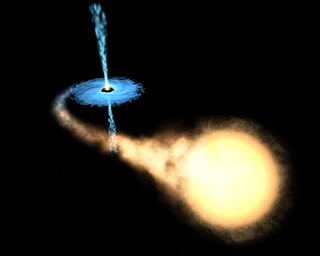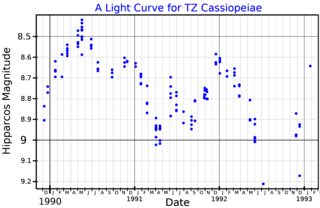
A star is a luminous spheroid of plasma held together by self-gravity. The nearest star to Earth is the Sun. Many other stars are visible to the naked eye at night; their immense distances from Earth make them appear as fixed points of light. The most prominent stars have been categorised into constellations and asterisms, and many of the brightest stars have proper names. Astronomers have assembled star catalogues that identify the known stars and provide standardized stellar designations. The observable universe contains an estimated 1022 to 1024 stars. Only about 4,000 of these stars are visible to the naked eye—all within the Milky Way galaxy.

X-ray astronomy is an observational branch of astronomy which deals with the study of X-ray observation and detection from astronomical objects. X-radiation is absorbed by the Earth's atmosphere, so instruments to detect X-rays must be taken to high altitude by balloons, sounding rockets, and satellites. X-ray astronomy uses a type of space telescope that can see x-ray radiation which standard optical telescopes, such as the Mauna Kea Observatories, cannot.

A stellar wind is a flow of gas ejected from the upper atmosphere of a star. It is distinguished from the bipolar outflows characteristic of young stars by being less collimated, although stellar winds are not generally spherically symmetric.

X-ray binaries are a class of binary stars that are luminous in X-rays. The X-rays are produced by matter falling from one component, called the donor, to the other component, called the accretor, which is either a neutron star or black hole. The infalling matter releases gravitational potential energy, up to 30 percent of its rest mass, as X-rays. The lifetime and the mass-transfer rate in an X-ray binary depends on the evolutionary status of the donor star, the mass ratio between the stellar components, and their orbital separation.

Red supergiants (RSGs) are stars with a supergiant luminosity class and a stellar classification K or M. They are the largest stars in the universe in terms of volume, although they are not the most massive or luminous. Betelgeuse and Antares A are the brightest and best known red supergiants (RSGs), indeed the only first magnitude red supergiant stars.

Wolf–Rayet stars, often abbreviated as WR stars, are a rare heterogeneous set of stars with unusual spectra showing prominent broad emission lines of ionised helium and highly ionised nitrogen or carbon. The spectra indicate very high surface enhancement of heavy elements, depletion of hydrogen, and strong stellar winds. The surface temperatures of known Wolf–Rayet stars range from 20,000 K to around 210,000 K, hotter than almost all other kinds of stars. They were previously called W-type stars referring to their spectral classification.

A blue supergiant (BSG) is a hot, luminous star, often referred to as an OB supergiant. They are usually considered to be those with luminosity class I and spectral class B9 or earlier, although sometimes A-class supergiants are also deemed blue supergiants.

The following outline is provided as an overview of and topical guide to astronomy:

The Arches Cluster is the densest known star cluster in the Milky Way, about 100 light-years from its center in the constellation Sagittarius, 25,000 light-years from Earth. Its discovery was reported by Nagata et al. in 1995, and independently by Cotera et al. in 1996. Due to extremely heavy optical extinction by dust in this region, the cluster is obscured in the visual bands, and is observed in the X-ray, infrared and radio bands. It contains approximately 135 young, very hot stars that are many times larger and more massive than the Sun, plus many thousands of less massive stars.

Westerlund 1 is a compact young super star cluster about 3.8 kpc away from Earth. It is thought to be the most massive young star cluster in the Milky Way, and was discovered by Bengt Westerlund in 1961 but remained largely unstudied for many years due to high interstellar absorption in its direction. In the future, it will probably evolve into a globular cluster.

An O-type main-sequence star is a main-sequence star of spectral type O and luminosity class V. These stars have between 15 and 90 times the mass of the Sun and surface temperatures between 30,000 and 50,000 K. They are between 40,000 and 1,000,000 times as luminous as the Sun.

WR 136 is a Wolf–Rayet star located in the constellation Cygnus. It is in the center of the Crescent Nebula. Its age is estimated to be around 4.7 million years and it is nearing the end of its life. Within a few hundred thousand years, it is expected to explode as a supernova.

A hypergiant (luminosity class 0 or Ia+) is a very rare type of star that has an extremely high luminosity, mass, size and mass loss because of its extreme stellar winds. The term hypergiant is defined as luminosity class 0 (zero) in the MKK system. However, this is rarely seen in literature or in published spectral classifications, except for specific well-defined groups such as the yellow hypergiants, RSG (red supergiants), or blue B(e) supergiants with emission spectra. More commonly, hypergiants are classed as Ia-0 or Ia+, but red supergiants are rarely assigned these spectral classifications. Astronomers are interested in these stars because they relate to understanding stellar evolution, especially star formation, stability, and their expected demise as supernovae. A common example of a hypergiant is UY Scuti, although being a supergiant UY Scuti is considered a hypergiant by some people.

A red giant is a luminous giant star of low or intermediate mass in a late phase of stellar evolution. The outer atmosphere is inflated and tenuous, making the radius large and the surface temperature around 5,000 K or lower. The appearance of the red giant is from yellow-white to reddish-orange, including the spectral types K and M, sometimes G, but also class S stars and most carbon stars.

TZ Cassiopeiae(TZ Cas, HIP 117763, SAO 20912) is a variable star in the constellation Cassiopeia with an apparent magnitude of around +9 to +10. It is approximately 8,400 light-years away from Earth. The star is a red supergiant star with a spectral type of M3 and a temperature around 3,600 K.

WR 25 is a binary star system in the turbulent star-forming region the Carina Nebula, about 6,800 light-years from Earth. It contains a Wolf-Rayet star and a hot luminous companion and is a member of the Trumpler 16 cluster. The name comes from the Catalogue of Galactic Wolf–Rayet Stars.

An O-type star is a hot, blue-white star of spectral type O in the Yerkes classification system employed by astronomers. They have temperatures in excess of 30,000 kelvins (K). Stars of this type have strong absorption lines of ionised helium, strong lines of other ionised elements, and hydrogen and neutral helium lines weaker than spectral type B.

Theta Muscae is a multiple star system in the southern constellation Musca, containing a Wolf-Rayet star and two massive companions. With an apparent magnitude of 5.5, it is the second-brightest Wolf–Rayet star in the sky, although much of the visual brightness comes from the massive companions and it is not one of the closest of its type.

IRAS 05280–6910 is a red supergiant star or OH/IR supergiant star located in the Large Magellanic Cloud. IRAS 05280−6910 was found towards the cluster NGC 1984. Its radius is calculated to be more than a thousand times that of the Sun, making it one of the largest stars discovered so far. If placed at the center of the Solar System, its photosphere would engulf the orbit of Jupiter. It has an estimated mass loss rate of 5.4×10−4 M☉ per year, one of the highest known for any red supergiant star.



















